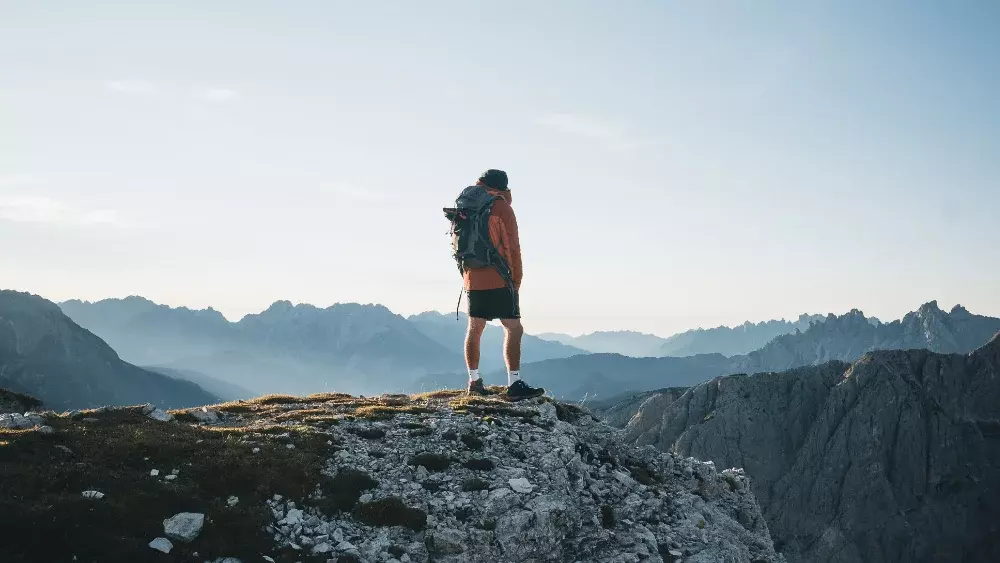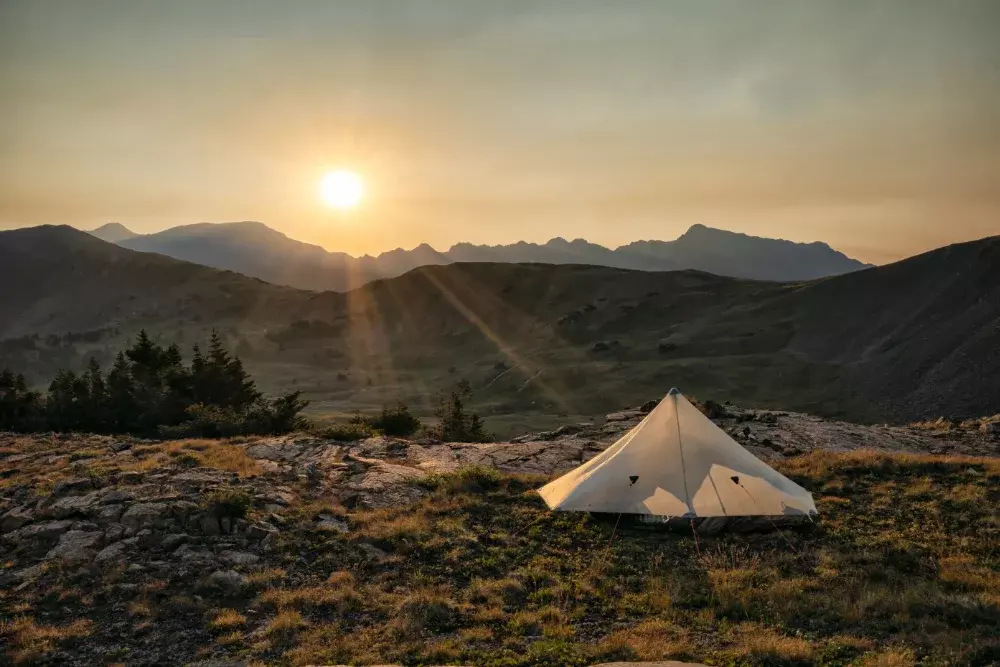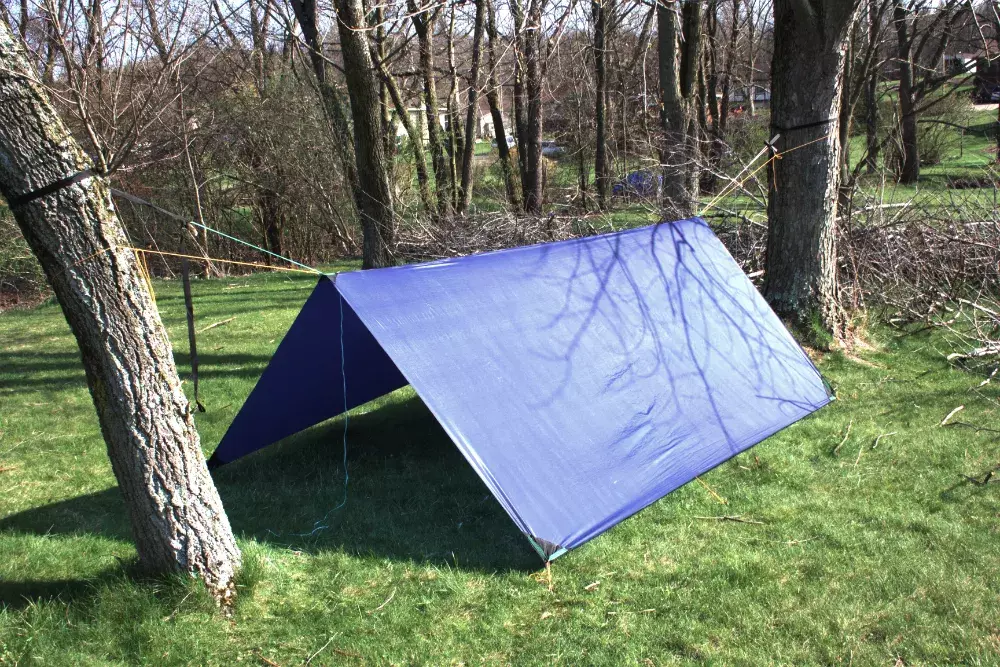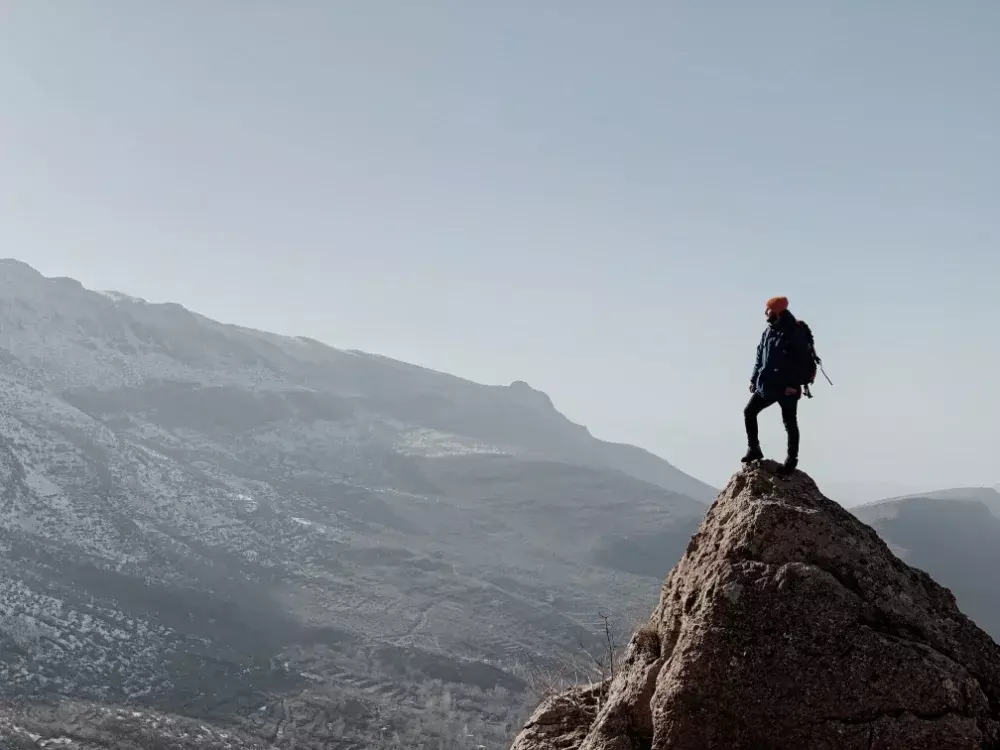They saw off the handles of their toothbrushes, cook their food with DIY camping stoves made from beer cans, and cut the straps off their backpacks to save the last 20 grams: Ultralight backpackers. Descriptions of this type of trekking often sound very adventurous. We’ll be explaining what ultralight trekking is all about and sharing tips on how to reduce the weight of your backpack during long distance hikes in this blog post.
Table of Contents
What Is Ultralight Backpacking Anyway?
The Short Version
Ultralight backpacking (often abbreviated as UL) is a subcategory of trekking/backpacking where the weight of the equipment carried plays a major role. An ultralight backpacker is someone who, by definition, tries to keep their base weight below a certain limit to avoid carrying unnecessary weight on long-distance treks.
Over time, a maximum base weight of 10 pounds has become a commonly followed rule among ultralight backpackers. That is the equivalent of about 4.5 kg. However, in countries that use the metric system, the weight limit is commonly rounded up to 5 kg. Base weights up to around 20 pounds (approximately 9 kg) are generally referred to as lightweight backpacking, while anything beyond that is considered classic backpacking. The most extreme form of UL backpacking is called Super Ultra Light (SUL) backpacking. Given the maximum base weight of 5 pounds (approximately 2.3 kg), this type of backpacking should be undertaken only by very experienced long-distance hikers.

Key figures of Ultralight backpacking
What exactly does this base weight refer to? Simply put, it includes everything you carry on your back while long-distance hiking, except for water, food, and fuel. The backpack itself is also included in the base weight. Base weight is often referred to as BPW (Base Pack Weight). Water, food, and fuel are referred to as consumable weight (CW). Usually hygiene items such as toothpaste and soap are included in the base weight. Unlike the consumable weight, the base weight does not change significantly during the trekking tour and has therefore established itself as a reference weight.
Another category is the weight worn, that is, clothing and shoes. Trekking poles also fall under this category. A term that one only occasionally comes across in the scene is Skin Out Weight (SOW). Skin Out Weight (SOW) is the total weight of one’s gear and clothing/shoes, excluding any consumables. The term Total Weight (TW), on the other hand, refers to the total weight INCLUDING consumable weight. It’s important not to confuse Total Weight with Total Pack Weight (TPW), which is the weight of your backpack (including everything inside and attached to it) at the beginning of your trek.
While ultralight trekking places a lot of emphasis on reducing base weight, the weight of clothing and footwear is sometimes neglected. However, these factors also play a critical role in how much strain is placed on the body Nonetheless, Worn Weight and Total Weight are not suitable as reference weights. After all, a size 6 shoe weighs much less than a size 10 shoe, and the amount of food you will need on a trek also varies from person to person.
Here are all the abbreviations at a glance:
- BPW: Base Pack Weight
- CW: Consumable Weight
- SOW: Skin Out Weight
- TPW : Total Pack Weight
Whether hikers must strictly follow these weight guidelines during long-distance treks is a topic of much debate within the community, particularly with regards to the length and destination of the trip. Winter hikes or hikes off the beaten path have different requirements than a summer hike on long-distance trails through villages and towns How much you want to stick to the maximum base weight is entirely up to you!

How to Reduce Weight
The average backpack for a long-distance hike weighs well over 10 kg. So, how can you achieve the desired weight of less than 20 or 10 pounds? Since there is no official guide, we’d like to share some points that are frequently mentioned in books, forums, and blog posts. As you’ll soon realize, achieving an ultralight pack is not about purchasing the most expensive gear on the market.
Weigh Each Piece of Equipment
This point is self-explanatory, isn’t it? By weighing each item of gear you plan to bring on your trek, you can identify which pieces are the heaviest and where there’s potential to reduce weight. Using spreadsheet programs like Excel makes it easier to present all the information in a clear and organized manner. When weighing your gear, it’s important to use an accurate scale. A high-quality kitchen scale is recommended over a bathroom scale for the most precise measurements.
Leave Unnecessary Gear at Home
Taking a critical look at the gear you do bring can help you identify opportunities for further weight savings. Take each piece of equipment in your hand and ask yourself: Do I really need this? What function does it perform on my long-distance hike? Do you necessarily need several sets of clothes to change, or can you wash them in between? Do you need shampoo and soap or can you wash your hair with a bar of soap?
Reduce the weight of the big 3
The Big 3, also called the Big 4, are usually the heaviest pieces of gear on a long-distance hike. This refers to the shelter (tent, tarp), sleeping bag and sleeping pad, and backpack. To reduce weight, there are several methods, one of which is the 3 for 3 method by Jörgen Johansson. In short, when reducing weight, you should start by bringing the Big 3 to a weight of under 3 kg. Then you are well on your way to staying under the reference weight of 5 kg. This is where it makes particular sense to go for ultra-light equipment.
By reducing the weight of your overall equipment for your trekking trip, you may not need a large, heavy backpack anymore and may even be able to forgo the frame. This way you save twice on weight! With the reduced weight, you may even be able to forgo heavy hiking boots depending on the terrain of the trail and hit the path with trail runners instead.
Planning
If you want to keep the weight down, you need to focus on the items you really need. Before you can start reducing the weight of your gear, you first need to determine what exactly is essential for your long-distance hike. Before embarking on any trekking tour, it’s essential to do some research on the trail conditions. Knowing how often you can resupply food, where you can find drinking water along the trail, and what kind of weather conditions your equipment needs to withstand is essential for ultralight backpacking. For example, when trekking in the summer, you don’t necessarily need to carry a 4-season sleeping pad.
Swap Gear for Skills
This point is closely related to the point planning. Knowing exactly how often and where you can find drinking water along the trail means you don’t have to carry as much water with you. As your experience grows, you’ll develop a better sense for assessing situations and navigating the long-distance trail safely even with minimal gear. To familiarize yourself with your ultralight gear, test it out in the backyard or in the woods near your car. This way you can see if your setup is doing its job and adjust it if necessary.
Reduce Consumable Weight
Certainly, it’s important not to bring too little food with you since long-distance hiking burns a lot of calories. This is exactly why precise planning of the required food is important. If you end up taking back half of your food with you, it means you didn’t plan your food needs properly. You should also pay attention to a high caloric density. Nut mixes and dehydrated food are great options for long-distance hiking as they provide a lot of energy while weighing very little.
Toiletries are available in travel sizes, but the packaging for these is still relatively heavy. Alternatively, you can fill the required amount in ultra-light containers and use soap and toothpaste tabs instead of shower gel and toothpaste. Resealable plastic bags are a popular choice for storage due to their lightweight nature, but unfortunately, they are not very sustainable.
Make Existing Gear Lighter
Here we come to the famous, often ridiculed toothbrush with the sawed-off handle. But this toothbrush only serves as a symbol for this method of weight reduction. You can also remove unneeded pockets on the backpack, shorten the straps, or remove labels from clothing and equipment. Only a few grams are saved per item, but these still add up in the end and make your backpack lighter.
Use Multi-Purpose Gear
Multipurpose gear refers to equipment that performs more than one function. Trekking poles are converted into tent poles, spare clothes become a pillow, and the bandana serves as a sweatband, towel, or dishcloth. Another classic example is the poncho tarp, which can be used as a rain poncho during the day on a long-distance hiking trail and as a tarp at night.

Make your Own Gear (MYOG)
Ultralight trekkers are known to tinker, and for good reason. By tailoring your gear to your individual needs, you can save quite a bit of weight on a long-distance hike. One of the most well-known examples is probably the can stove, which involves crafting a camping stove out of a beverage can. You can find instructions on how to do this here, for example. Additionally, ultralight Backpacks, groundsheets and many other items can be made through DIY methods. However, it is important to have at least some level of skill and experience, and to extensively test any homemade equipment before relying on it during a trek.

Why Ultralight Backpacking?
The Philosophy Behind Ultralight Backpacking
It may sound like there’s a lot of technicalities involved, and indeed, ultralight backpacking does require a fair amount of technical knowledge and skills. The equipment is weighed down to the gram, tweaked and fiddled with, and packing lists are systematically compiled in Excel spreadsheets.
Nevertheless, ultralight backpacking is not just about pack weight, miles traveled on the long-distance trail, or speed. There is a philosophy and attitude to life behind the term. Ryan Jordan defines it as follows in his book “Lightweight Backpacking and Camping: A field guide to wilderness, hiking equipment, technique and style”:
“Lightweight Backpacking is not about sacrificing comfort, safety or a good time. It is certainly not about having the best most expensive gear money can buy — lightweight backpacking is about doing more with less”.
So it’s all about doing more with less. It’s not about carrying the absolute lightest weight possible, but carrying exactly what is necessary for the conditions on the long-distance hike – no more, no less. It can be liberating to give up comforts and live simply. The philosophy behind ultralight backpacking is closely linked to the minimalism movement. Many Ultralight Backpackers firmly believe that by carrying only the essential items on their long-distance hike, they can focus more on what truly matters: nature, self-reflection, and the solitude of the trail. Eliminating unnecessary items helps to avoid distractions and allows for greater mindfulness, enabling one to live in the present moment.
For those who may find the previous explanations too abstract or philosophical, we have listed some more concrete benefits of ultralight backpacking below:
The Health Benefits of Ultralight Backpacking
The health benefits of using ultralight equipment are perhaps the most obvious advantage. Anyone who has ever carried a heavy backpack for several miles knows how uncomfortable and burdensome it can be. Carrying a heavy backpack on a long-distance hike can not only be uncomfortable, but in the worst case scenario, it can also lead to health issues. In the short term, carrying a heavy backpack can result in exhaustion by the end of the day, sore muscles, and even joint or back pain. In the long run, a backpack that is too heavy when trekking can lead to chronic problems with the back as well as joints and even the spine. Furthermore, the risk of injury increases due to limited freedom of movement, making one more susceptible to falls, especially on challenging terrain.

Faster, longer, further
Due to the reduced weight, you use less energy when walking. This enables you to walk faster and cover greater distances per day. Especially when going uphill, every gram on your back can be felt. It is common to experience a noticeable decline in strength, particularly towards the end of a trekking tour. Carrying a lighter backpack can help conserve your energy reserves, allowing you to embark on longer long-distance hikes. Older long-distance hikers, in particular, may struggle with carrying a heavy backpack for multiple days and may benefit greatly from lightweight or ultralight backpacking.
The Drawbacks/Dangers of Ultralight Trekking
Ultralight backpacking is often only recommended to experienced long-distance hikers. It is impossible to be fully prepared for all potential situations that may arise while trekking on a long-distance trail. By foregoing non-essential items and carefully planning the equipment needed for each stage of the trail, there is even less wiggle room. As a result, without adequate preparation and experience, one may find themselves in uncomfortable, and in the worst case, even dangerous situations. Despite one’s ambitions, it is important to pay attention to the following things:
Adequate protection from wind and weather: Is your equipment suitable for unexpected changes in weather, and can it handle lower temperatures than originally planned? Can your shelter withstand strong winds?
First aid kit: Do you have an adequate supply of first aid materials with you? It is better not to save at the wrong end here.
Protection from wildlife: while a tarp is lighter than a tent, it also offers less protection from ticks, mosquitoes and doesn’t shield you as much from the outside world. Here, it is important to weigh your options carefully and to inform yourself in advance about the wildlife on the trail.
Properties of ultralight equipment: Ultralight materials are not only lighter, but also usually thinner and less robust than conventional materials. Lighter constructions, for example backpacks without carrying frame and padding, also reduce stability. That doesn’t mean your ultralight gear won’t survive your trek, but you’ll have to accept certain sacrifices in comfort, function and durability.
Safety First! As always, don’t take unnecessary risks. A few grams over your maximum weight is not worth putting yourself in danger.
Conclusion
We hope that we have provided you with a comprehensive overview of the topic. Perhaps ultralight backpacking is an option worth considering for your next long-distance hike? As always, you can find the right trail in our trail search!
The UL community is very active and has grown steadily in recent years. If you’re interested in connecting with other Ultralight backpackers, you can check out the r/Ultralight subreddit, which has a community of almost 600,000 members. There you will also find a very detailed overview of the topic in the index. For German-speaking hikers, there’s also the very active Ultralight Trekking Forum where you can engage in discussions and share information in German.

